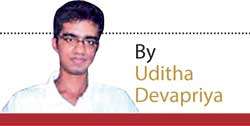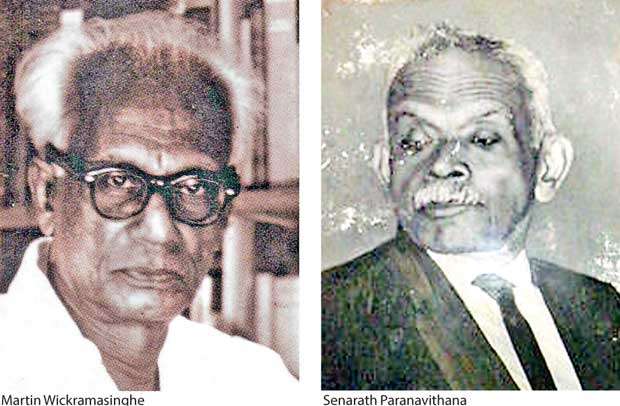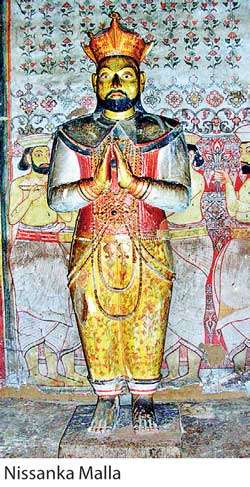29 Jan 2019 - {{hitsCtrl.values.hits}}
Our cultural landscape: From Anuradhapura to Kandy
 The evolution of the arts in Sri Lanka can, historically, be traced to three distinct events: The adoption of Buddhism as the State religion in the Anuradhapura era, the bifurcation between the ornate Maha Sampradaya and the austere Chula Sampradaya after the collapse of the Polonnaruwa era, and the onslaughts of colonialism, which shifted the centre of the country from the rural to the urban regions.
The evolution of the arts in Sri Lanka can, historically, be traced to three distinct events: The adoption of Buddhism as the State religion in the Anuradhapura era, the bifurcation between the ornate Maha Sampradaya and the austere Chula Sampradaya after the collapse of the Polonnaruwa era, and the onslaughts of colonialism, which shifted the centre of the country from the rural to the urban regions.
If we simplify this further, we can trace the history of the art of this country to three phenomena or, for the lack of a better word, things: Buddhism, Secularisation, and urbanisation.
From the one to the other there is a geographic shift, from Anuradhapura in the second century to Colombo in the first three decades of the 20th century.
Arbitrary periodisation of history can, as Kumari Jayawardena put it, “often be misleading”, but it is essential to generalise an otherwise complex reality.
Besides, this attempt at periodisation conforms to a consensus: that art in Sri Lanka began with Buddhism.
The development of irrigation techniques, the culmination of which was the bisokotuwa, was a clear manifestation of the link between the State and Buddhism; as Martin Wickramasinghe makes it clear in the first two chapters of his book Sinhala Sahithyaye Nageema, literature was tied up with the lives of peasants, most of whom lived around, and depended on, the wewa.

It is worth bearing in mind... that life in ancient times centred on the pursuit of agriculture, and that the Sinhalese depended, for their agricultural purposes, on the tank. Hence it is that the construction of tanks is bound up with the growth of Sinhalese civilisation from its early beginnings. One cannot, therefore, ignore the part that tanks have played in originating the culture of the Sinhalese and in moulding its later character.
When Buddhism was adopted as the State religion, there was a flourishing of the arts seen most clearly in rock and cave inscriptions. Wickramasinghe’s contention was that this went against the notion that Theravada Buddhism was opposed to the arts, for “a people who showed such good taste in the medium of plastic arts” couldn’t have been unable to express themselves through literature. Unfortunately, there was no evidence of any literary works of merit being written in this period.
From Anuradhapura to Polonnaruwa the idiom, because of the threat of invasion from South India, became more and more imitative to the point where, after a hefty debate, the kovil got close to the temple compound for the first time. Raja Chola’s conquest of Sri Lanka in the 11th century thus gleaned two paradoxical responses from the people and their rulers, in that there was opposition to and a fondness for Indian forms of architecture, specifically Dravidian architecture.
The invasion necessitated the recovery of Buddhism, achieved in the reign of Parakramabahu I with the triumph of the Mahavihara monks over the heretics of Abhayagiriya and Jetavana.
While art became less indigenous even in the style of dagabas towards the latter part of the Polonnaruwa kingdom, the need to salvage Buddhism and forge an identity based on it meant that the link between the religion and the State on the one hand and the religion and the people on the other became stronger. It was at this point that the clergy began to enter secular life.
Nissanka Malla, the second of the three unifying figures in our history (the other two being Vijayabahu I and Parakramabahu VI) recognised this when, after unifying the country, he decreed that only a Buddhist could rule it.
Not that the polity would turn exclusively Sinhalese Buddhist after him; as R. A. L. H. Gunawardhana notes in his celebrated essay The People of the Lion, there was never a unifying racial-religious identity even at the time of the Nayakkar kings.
Pali continued to be the epicentre of national literature, as Sinhalese, according to Wilhelm Geiger, underwent a profound transformation between the fifth and the eighth centuries.
The rule of all literary works in this period, moreover, was laid down in the Siyabaslakara: “peden budu sirita”, or simply, that “all verse must be in praise of the Buddha.”
Whether or not it stunted the arts is grist for another debate; for the time being what needs to be pointed out is that irrigation and Buddhism were, until then, the two greatest influences on the development of the arts.
The Polonnaruwa era thus, naturally, saw the publication of literary works, which reinforced and continued this link: the Dathavamsa; the Culavamsa; Gurulugomi’s Amavatura; and the Dharmapradipikava.
There were two other works, influenced heavily by Sanskrit poetics, and criticised by both Wickramasinghe and Munidasa Cumaratunga later on, the Sasadavata and the Muvadevadavata.
Here the road bifurcates, and a stronger historical tendency takes over the pervasive influence of Buddhism: the chasm and conflict between the Sanskrit Alankarists on the one hand and the less ornate and sensual poets on the other.
The evolution of the arts in Sri Lanka can, historically, be traced to three distinct events: The adoption of Buddhism as the State religion in the Anuradhapura era, the bifurcation between the ornate Maha Sampradaya and the austere Chula Sampradaya after the collapse of the Polonnaruwa era, and the onslaughts of colonialism, which shifted the centre of the country from the rural to the urban regions
This was the rift between the Maha Sampradaya and the Chula Sampradaya, with the two contenders for the literary prize being the Kavsilumina and the Guttila Kavya.
The former was one of the many courtly romances that valorised the king, though from the standpoint of Buddhism; adherence to Buddhist tenets, no matter how ornate the prose or poetry, was important owing to the rule in Siyabaslakara, which is why even when the Kavsilumina strayed into erotica, it stayed within the confines of a Jataka Story which affirmed, rather than opposed, sexual prudery.
 For Geiger this period represents a renaissance in the Sinhala language, a point rebutted by Senarath Paranavithana and later on, impliedly, by Wickramasinghe as well.
For Geiger this period represents a renaissance in the Sinhala language, a point rebutted by Senarath Paranavithana and later on, impliedly, by Wickramasinghe as well.
Perhaps it had to do with the shift from Anuradhapura and Polonnaruwa and the destruction of the irrigation network that had bound the people to the land
until then.
The new kingdom in Dambadeniya represented a shift from the Buddhist ethos of the last few centuries to a multicultural ethos through the intrusion of Dravidian practices and architecture.
The kovil, for instance, which in the Polonnaruwa era had come closer to the temple compound, entered it after the 12th century.
The Gampola era essentially continued this trend, with the main redeeming point being the rise of a new literary genre: the Sandesa Kavya, to be given a fresh lease of life in the Kotte era through Thotagamuwe Rahula against his own tutor, Vidagama Maithri.
But again, even here the influence of the Sanskrit Alankarists was apparent, since the sandesha genre (according to some) borrowed from Kalidasa.
K. M. de Silva referred to the kavyawal as “secular in spirit and tone”, which made them “a useful source of information on the social and political conditions of the country.” Tissa Abeysekara, however, disagreed; for him, the secularisation of poetry began with the shift in diction in the 18th century, long after the demise of the Kotte kingdom. It would not, however, be wrong to view the sandesa kawyawal as laying the foundation for the more secular verses of the Matara Poets.
The Kandyan kingdom saw the end of the great tradition fostered by the Dambadeniya and Gampola monarchs.
The greater versus lesser tradition debate continued, but the collapse of the classical tradition meant that the literature of this period got closer to the people: there was a revival of folk poetry, attempts at biographies, and even a few essays in erotic literature which championed masculinity.
The revival of Buddhism in the reign of Kirti Sri Rajasinghe led to literary forms which could not have been more different to the polished diction of the preceding centuries.
There was, in other words, a new sensibility invading the cultural landscape, and it was seen even in the realms of art and architecture; more than ever before, there was widespread interest in rebuilding the ruins of Anuradhapura and Polonnaruwa. It was an attempt at salvaging a dying heritage, and it threw up the last few embers of an era which would be followed by more than a century of British rule.
It is at this juncture that the dominant tendency in the evolution of the arts changes for the second time, this time to the concentration of economic, political, and cultural capital in the metropolis, or a trend towards urbanisation underscored by the rise of three milieus: the old elite, the nascent bourgeoisie, and the lower middle and working class, the latter of whom, in the 19th century, stepped in to revive the arts of this country through the vehicle of Sinhala Buddhist nationalism.
The writings of Martin Wickramasinghe, K. M. de Silva, Kumari Jayawardena, Tissa Abeysekara, and Kamalika Pieris were used for this essay.
30 Nov 2024 2 hours ago
30 Nov 2024 5 hours ago
30 Nov 2024 6 hours ago
29 Nov 2024 29 Nov 2024
29 Nov 2024 29 Nov 2024